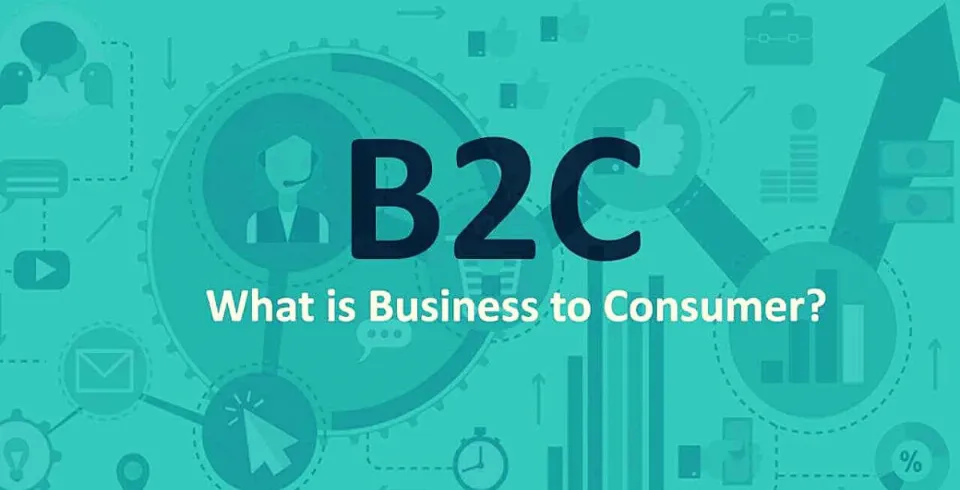B2C -- short for business-to-consumer -- is a retail model where products move directly from a business to the end user who has purchased the goods or service for personal use. It is often contrasted with the B2B (business-to-business) model, which involves exchanging goods and services between businesses instead of between businesses and consumers.
The term B2C is applicable to any business transaction where the consumer directly receives goods or services -- such as retail stores, restaurants and doctor's offices. Most often it refers to e-commerce businesses, which use online platforms to connect their products with consumers.
While some B2C businesses use their platforms to market and sell their own products, others make money by connecting buyers to sellers, using content traffic to sell advertisement spaces or restricting content to paid subscriptions.
Among e-commerce giants like Amazon and eBay, other recognizable B2C companies include The New York Times, Facebook, Netflix and Uber.
In recent years, B2C e-commerce has experienced a surge in popularity, accounting for 56.9% of retail gains from 2018 to 2019, with contributions from large companies such as Amazon. Additionally, the COVID-19 pandemic increased e-commerce sales between 40% to 60% in the first few months of 2020.
How does B2C work?
B2C businesses sell goods and services directly to their consumers. A consumer can be defined as an end user who purchases a product or service for personal use. Though many businesses sell their own products, this is not a requirement for the B2C model since many companies also sell products purchased from other businesses.
A B2C retail experience can be shopping at a local grocery store or purchasing new headphones from an online store. A B2C service experience can be a visit to the doctor, visiting a hair or nail salon, dining out at a restaurant or using the Uber app to purchase transportation.
Types of B2C companies
Though the term "B2C" is most frequently used to refer to retailers and marketplaces, it can also be applied to content and service providers.
B2C businesses can vary significantly. Some businesses may choose to adopt a combination of profit models -- as many business models incorporate advertising and fee-based approaches together.
Common types of B2C companies include the following:
- Direct sellers. The most common and familiar e-commerce business, where customers purchase directly from the seller.
- Examples: Zappos, Gap.com and Target.com
- Intermediaries. Rather than offering their own products or services to shoppers on their site, these e-commerce companies offer a platform for C2C (consumer-to-consumer) markets, connecting buyers with independent sellers. Intermediary companies often profit by charging a small percentage of each sale from vendors.
- Examples: Etsy, Poshmark, eBay and Expedia
- Advertising-based. These e-commerce companies use traffic-driving strategies like content marketing to connect shoppers with relevant advertisements for products and services. In this scenario, the website profits from selling advertising space.
- Example: HuffPost
- Community-based. Similar to advertising-based businesses, community-based companies use online communities centered around specific identities or interests and information such as demographic data and geographic location to connect website-goers with targeted ads.
- Example: Facebook and online forums
- Fee-based. These e-commerce businesses require a paid subscription in exchange for unrestricted access to their content.
- Example: The Wall Street Journal, The New Yorkerand Netflix
- Brick-and-mortar. A physical location of a business or retail establishment where consumers can enter the store, touch and hold the merchandise and buy products or services in-person.
- Example: Restaurants, doctors' offices, J.Crew storefronts, car rental branches and salons
B2C vs. B2B
The primary difference between the B2C and B2B retail models is who the company sells to. B2C businesses sell directly to consumers, while B2B companies sell to other businesses; these other businesses might then go on to serve other businesses or consumers.
Other differences include the following:
- B2C
- Smaller purchase size and lower dollar amounts.
- Purchases are made for individuals or households. Buying decisions may include influencers or other users.
- The sales process tends to be more product- or service-driven and less relationship-driven -- excluding service providers.
- Frequent impulse buys and emotional buying decisions can be made.
- The sales cycle is much shorter; the buying process is often a single step.
- Purchases revolve around immediate results and gratification.
- Brand identity is emphasized.
- Marketing departments frequently take a larger percentage of the overall expense.
- B2B
- Larger purchase sizes and higher dollar amounts.
- Many people are involved in the buying decisions and they can be from multiple departments in an organization.
- Relationship-driven sales process.
- Highly calculated, rational buying decisions.
- Longer, more complex sales cycle.
- Purchases are based on long-term goals.
- Marketing departments take up a small percentage of the overall expense.
B2C and B2B transactions can be similar when it comes to considered purchases -- which are buying decisions with higher degrees of risk and reward, both financially and emotionally. B2B transactions are nearly always considered purchases. B2C transactions with high dollar amounts -- such as buying a new house or paying for a college education -- tend to be considered purchases.
B2C considered purchases, like B2B transactions, frequently have the following:
- longer, more complex sales cycles;
- rationale-based buying decisions; and
- multiple decision-makers.
How is marketing different for B2C businesses?
Many B2C businesses -- particularly brands with broad audiences -- spend a large percent of their overall expenses on marketing. Advertisements -- such as videos or commercials -- are frequently used in B2C marketing since they can target wide audiences, appeal to emotions and increase brand awareness.
In contrast, B2B companies focus on marketing to very specific clients, making broad advertising -- through channels such as print, TV and social media -- ineffective and expensive.
In addition, B2C marketing focuses on targeting users and buyers who match particular demographics. Cross-selling and upselling can be a significant source of sales for B2C retailers -- especially e-commerce sellers. Individual shopper data can be used effectively to create personalized shopping recommendations. However, lead management is practiced far less by B2C companies since the sales cycles tend to be short.
Unlike B2B companies, the marketing efforts of certain B2C companies in the retail space have started to focus on the customer experience (CX) -- how customers shop, buy, unbox and own products.
Benefits of B2C e-commerce
B2C e-commerce models have been associated with a number of potential benefits, including the following:
- Globalization. Larger-scale B2C businesses frequently have very large target audiences. Therefore, advertisements and marketing campaigns can reach millions of potential customers, via the internet and social media.
- Relatively low cost. E-commerce B2C models can cut down on operational and physical infrastructure costs.
- Customer personalization. B2C businesses can directly market to consumer segments and niche target audiences, allowing companies to personalize their marketing for individual consumers.
- Direct customer experience. Both online and brick-and-mortar businesses have complete control over user experiences. This control can lead to better customer service, increased cross-selling and customer loyalty.
- Customer data. Valuable customer data -- such as sales conversion stats, email addresses for marketing automation, analytics, customer behavior patterns, geographic regions and psychographics -- can strengthen a business's marketing strategy and provide insights about users.
Examples of B2C businesses
Popular examples of brick-and-mortar B2C retailers include the following:
- H&M
- Costco
- Walmart
Other examples of physical B2C businesses include the following:
- Doctors' offices
- Restaurants
- Convenience stores
- Hair and nail salons
- Spas
- Pet groomers
Popular examples of e-commerce B2C businesses include the following:
- The Atlantic
- The New York Times
- HuffPost
- Uber
- Ikea
- Baidu
- Amazon
- Zappos
- eBay
- Etsy
- Rakuten
- Alibaba
- Airbnb
- Wayfair
- Poshmark
- YouTube
- Netflix
Editor's note: This article was written by Wesley Chai in 2020. TechTarget editors revised it in 2022 to improve the reader experience.


